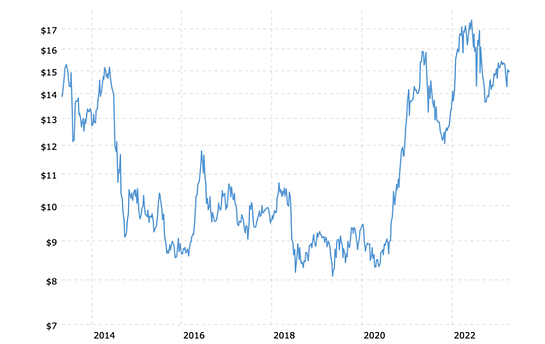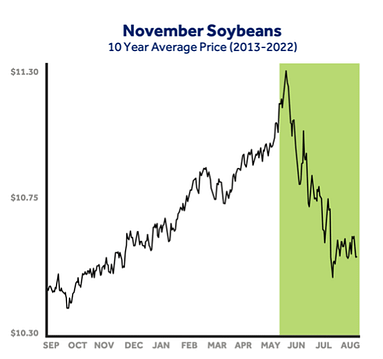Soybean Price Seasonality Creates Opportunity
As planters take to the fields across the northern hemisphere, soybean prices remain elevated on a historical basis (Chart 1) despite projections for an increase in planted acres. This creates opportunities for producers to forward price this year’s crop at profitable levels.
Chart 1 – 10-year nearby soybean price

Source: https://www.macrotrends.net/2531/soybean-prices-historical-chart-data
But when to sell? That’s always the question, and it can be a stressful decision. (That’s why this article was written – to help producers make more informed decisions.) To put this decision on auto-pilot, producers can enroll bushels into the ASP™ contract, which automatically prices a percentage of expected production during a seasonally preferable time of year.
By taking advantage of an ASP contract, you benefit from:
- Diversifying your grain marketing portfolio
- Leveraging an automatic execution component in your grain pricing program
- Capturing seasonal price advantages, rather than reactively selling on emotion
- Maintaining the control to “price out” if you see prices trending lower
The primary objective of any grain marketing strategy should be to protect and enhance farm profitability. Including ASP contracts in a soybean marketing program has delivered a solid return on investment (ROI) over time, providing a challenging benchmark for other marketing alternatives in the mix.
Long-term seasonal trend
On average over the past 10 years, the November soybean futures contract has been at its highest in late May, then it declined into the summer months. As a result, the ASP contract has been designed to take advantage of this seasonal strength by averaging sales from May 22 to August 4. This both creates a floor (the average) and leaves upside.
Chart 2

Past performance is not indicative of future results. ADM does not warrant this information to be free of omissions and errors.
From 2013-2022, the average annual gain for the ASP contract compared to the harvest price is 42-cents/bushel (Table 1). This simply means that by consistently enrolling a portion of their production over the years, a producer would have gained an average of 42-cents in the futures component of the price compared to selling off the combine at harvest. 42-cents is significant, that’s more than $25/acre for 60 bushel soybeans!
Table 1

What’s ahead
With soybean futures at the higher end of their historical range, and with the prospect of steadily growing supplies, it’s important to have a plan to protect and capture profitable prices.
No one knows whether soybean prices will fall in 2023. But in four of the five years where the ASP futures reference price was more than $10/bu, the contract was significantly better than selling at harvest. In the one year it didn’t gain, the contract showed a loss of 14-cents/bu. The price in early April 2023 for November soybean futures has been around $13/bu. The key is consistency.
Producers can use an ASP contract to spread sales over months of uncertainty related to new-crop supply when prices tend to build in seasonal premiums to compensate for crop production threats. The contract allows sales over the entire period from May 22-August 4 to determine a final futures reference price. But it also gives producers the choice and flexibility to end the pricing period early by pricing out of the contract at their discretion. For example, should futures prices decline, a producer may decide to avoid potential further declines by capturing the average price to that point and pricing remaining unpriced portions at the current market.
As with any forward pricing tool, ASP contracts should be used alongside soybean marketing best practices to determine how much of the crop to price ahead. Some of these include:
- Know the breakeven to understand profit levels and don’t forward contract at a price below the cost of production if possible.
- Market up to the amount of insurance coverage with a diversified contracting approach.
- Bushels produced over the amount of insured coverage should be assessed as the crop year goes on. They can be priced ahead of harvest once the crop is made or held to be priced after harvest.
Get Started
ASP™ contracts for soybeans require a 5-cent-bushel investment, and the deadline to enroll is May 12, 2023. Contact your ADM representative to enroll a portion of your expected production in a contract that works best for your operation and marketing objectives.
ADM is providing this communication for informational purposes, and it is not a solicitation or offer to purchase or sell commodities. The sources for the information in this communication are believed to be reliable, but ADM does not warrant the accuracy of the information. The information in this communication is subject to change without notice. If applicable, any information and/or recommendations in this communication do not take into account any particular individual’s or company’s objectives or needs, which should be considered before engaging in any commodity transactions based on these recommendations. ADM or its affiliates may hold or take positions for their own accounts that are different from the positions recommended in this communication.
